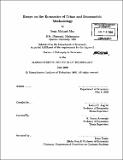| dc.contributor.advisor | Joshua D. Angrist and K. Daron Acemoglu. | en_US |
| dc.contributor.author | May, Sean, 1974- | en_US |
| dc.contributor.other | Massachusetts Institute of Technology. Dept. of Economics. | en_US |
| dc.date.accessioned | 2005-09-27T19:50:38Z | |
| dc.date.available | 2005-09-27T19:50:38Z | |
| dc.date.copyright | 2000 | en_US |
| dc.date.issued | 2000 | en_US |
| dc.identifier.uri | http://hdl.handle.net/1721.1/9003 | |
| dc.description | Thesis (Ph.D.)--Massachusetts Institute of Technology, Dept. of Economics, 2000. | en_US |
| dc.description | Includes bibliographical references (p. 119-123). | en_US |
| dc.description.abstract | The research presented in this thesis covers two topics: the economics of crime and econometric methodology. The first chapter addresses the question of whether higher wages reduce teenage crime rates. I exploit exogenous variation in the wages of teenagers resulting from federal minimum wage legislation. Instrumental variables estimates show a strong negative relationship between wages and arrest rates for burglary, larceny, motor vehicle theft, vandalism, and robbery. Wage elasticities of property crime arrest rates range between -1 and - 2. !n contrast with the results for property crime, wages do not have a strong impact on arrest rates for most violent crime. The second chapter examines the effect of crime on the labor market outcomes of victims. I use longitudinal data from the National Crime Victimization Survey to estimate the employment-related costs of crime. Estimates suggest that being the victim of a violent crime causes a transitory decline in the employment rates and household income of victims of 2 to 3 percent. Victims of property crime do not show a significant decline in employment rates or household income as a result of the crime. For victims of violent crime, average lost earnings are roughly $700, a figure close to estimates of the total property loss and medical costs suffered by victims of violent crime. The third chapter contains work, joint with Bryan Brown and Whitney Newey, that describes a relatively efficient moment-restricted bootstrap for generalized method of moments estimators. We show the bootstrap improves on the standard asymptotic approximation and illustrate that the bootstrap improvement can be large, as evidenced by Monte Carlo simulations and an empirical example in dynamic panel data models. | en_US |
| dc.description.statementofresponsibility | by Sean Michael May. | en_US |
| dc.format.extent | 123 p. | en_US |
| dc.format.extent | 10475513 bytes | |
| dc.format.extent | 10475273 bytes | |
| dc.format.mimetype | application/pdf | |
| dc.format.mimetype | application/pdf | |
| dc.language.iso | eng | en_US |
| dc.publisher | Massachusetts Institute of Technology | en_US |
| dc.rights | M.I.T. theses are protected by copyright. They may be viewed from this source for any purpose, but reproduction or distribution in any format is prohibited without written permission. See provided URL for inquiries about permission. | en_US |
| dc.rights.uri | http://dspace.mit.edu/handle/1721.1/7582 | |
| dc.subject | Economics. | en_US |
| dc.title | Essays on the economics of crime and econometric methodology | en_US |
| dc.type | Thesis | en_US |
| dc.description.degree | Ph.D. | en_US |
| dc.contributor.department | Massachusetts Institute of Technology. Department of Economics | |
| dc.identifier.oclc | 47366971 | en_US |
